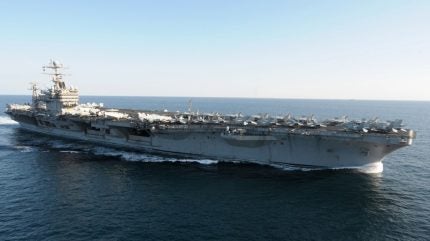
The US Secretary of Defence, Lloyd J Austin, has taken steps to extend the US force posture across sea, air and land in the Middle East at the end of last week (2 August 2024) in response to escalating tensions between Israel and Iran alongside its associated militant non-state actors.
Simultaneously, the Department of Defense reiterated its commitment to “de-escalating tensions in the region and pushing for a ceasefire as part of a hostage deal to bring the hostages home and end the war in Gaza” that has spiralled since the Palestinian and Iranian-backed militant group, Hamas, attacked Israel on 7 October 2023.
Another level of ballistic missile defence (BMD) at sea and land will bolster existing US capabilities deployed to protect Israel in its ongoing tit-for-tat missile exchange with Iran and its proxies. In addition, the US will also mobilise another fighter squadron – reinforcing their defensive air support capability.
No specific details have been released in relation to these latest deployments.
This new level of support was first devised in a call between the US President Joe Biden and Israeli Prime Minister Benjamin Netanyahu on 1 August.
Tit-for-tat
These air defence measures have been deployed in the event of another potential missile exchange, much like the Iranian standoff attack against Israel in April – made up of a salvo of missiles and one-way-attack uncrewed aerial systems – which Israeli interception largely prevented.
The vast missile and projectile stocks of the Lebanese militant group, Hezbollah, which is in close proximity to the north of Israel, presents a greater combined challenge alongside Iranian salvos to the US and Israeli interception rate.
Prior to these recent defensive measures, the Israeli government had sanctioned the assassination of a leading figure of Hamas, Ismail Haniyeh, in Tehran. Dr Burcu Ozcelik, a senior research fellow in Middle East security at the British think tank, the Royal United Services Institute, commented on the likely consequences of the attack.
“While it is not the first targeted assassination against a high-level figure within the so-called ‘Axis of Resistance,’ at this juncture of intense tit-for-tat and a high stakes geopolitical conflict, it will have ripple effects across the region.
“This calls into question what a coordinated response to Iranian retaliation—as seen in April to support Israel—may look like among regional states.”
Scope of US posture in the Middle East
The exact number of additional BMD-capable destroyers, cruisers and land systems to be deployed remains undisclosed.
However, the US Navy’s USS Abraham Lincoln carrier strike group (CSG) is set to replace the USS Theodore Roosvelt CSG, which has been operating in US Central Command since 12 July.
Also known as ‘CSG 3’, the group comprises the flagship USS Abraham Lincoln (CVN 72), Carrier Air Wing 9, guided-missile cruiser USS Mobile Bay (CG 53) and more guided-missile destroyers within the Destroyer Squadron 21 – which includes six warships.
Notably, there are several more warships in CSG 3 than in the Theodore Roosevelt CSG, which consists only of three vessels: the Nimitz-class carrier flagship, Carrier Air Wing 11 and an Arleigh Burke-class destroyer, USS Daniel Inouye (DDG 118).
These posture adjustments add to the broad range of capabilities the US military maintains in the region, including the USS Wasp Amphibious Ready Group/Marine Expeditionary Unit operating in the Eastern Mediterranean.
The group first entered the Mediterranean Sea, passing throught the Strait of Gibralter, on 26 June.
It consists of the amphibious assault ship USS Wasp (LHD 1), San Antonio-class amphibious transport dock ship USS New York (LPD 21), Harpers Ferry class dock landing ship USS Oak Hill (LSD 51), and embarked 24th Marine Expeditionary Unit.



